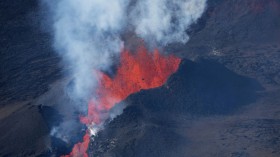Australia is currently transitioning from autumn into the winter season which will span from June to August this year.
The country's Bureau of Meteorology (BoM) stated that the weakening of La Niña can be one of the factors that will bring above-average rainfall for most parts of central and eastern Australia in the coming months.
Winter 2022 Climate Outlook

Based on the Winter 2022 Climate Outlook of BoM, "unusually wet conditions" may occur for inland areas of New South Wales, Queensland, Northern Territory, and South Australia, causing the risk of flash floods, particularly in low-lying areas.
The BoM emphasized floodwaters in low-lying areas in New South Wales and Queensland may flow into South Australia in the coming months.
Meanwhile, south-western Australia and south-western Tasmania are likely to receive below-average rainfall during the winter.
In some areas of Australia, the BoM estimated that there is over 80% chance of "unusually high winter temperatures" in the following coastal areas:
- Southwestern and northern Western Australia
- Northern Queensland and Northern Territory
- Southeastern New South Wales
- Southern and eastern Victoria
- Tasmania
Also Read: Australia Passing Through Months Of Pathetic Autumn Weather, Meteorologist Says
What is La Niña?
La Niña, which means "little girl" in Spanish, is a climate pattern and weather system in the Pacific Ocean and affects global weather.
During La Niña events, trade winds over the Pacific change the ocean surface temperatures by pushing warm air to the Western Pacific Ocean in Asia by removing it from the Eastern Pacific Ocean off the west coast of the Americas, according to the National Oceanic and Atmospheric Administration (NOAA).
In Australia and other countries in East Asia and Southeast Asia, the warm air then accelerates the process of evaporation and increases the amount of rainfall, which is comparatively higher without La Niña.
La Niña Impact in Australia
The BoM stated that the effects of La Niña in Australia are increased rainfall in the eastern, central, and northern parts of the country.
Moreover, daytime temperatures will decrease in the south of the tropics.
In summary, the Australian meteorological agency provides the following weather conditions in Australia brought by La Niña:
- Elevated frequency of tropical cyclones
- Above-normal wet conditions during the spring and summer seasons in northern and eastern Australia
- Cooler days and warmer nights
- Increased fire weather conditions for wildfire
- Prolonged heatwaves across southern Australia
- Premature start of the monsoon and wet season
These weather patterns are based on previous yet related natural phenomena pertaining to the impact of La Niña in Australia.
In the first quarter of 2022, Queensland and New South Wales experienced extreme heavy rain, causing widespread flooding and evacuations as residential and commercial establishments were submerged with floodwaters.
In early 2011, Tropical Cyclone Yasi, a destructive storm that initially struck northern Queensland, was powered by the La Niña weather cycle between 2010 and 2011, according to Nine News, Australia's national news service.
Related Article: Australia Will Experience More La Nina Weather This 2022
© 2024 NatureWorldNews.com All rights reserved. Do not reproduce without permission.





